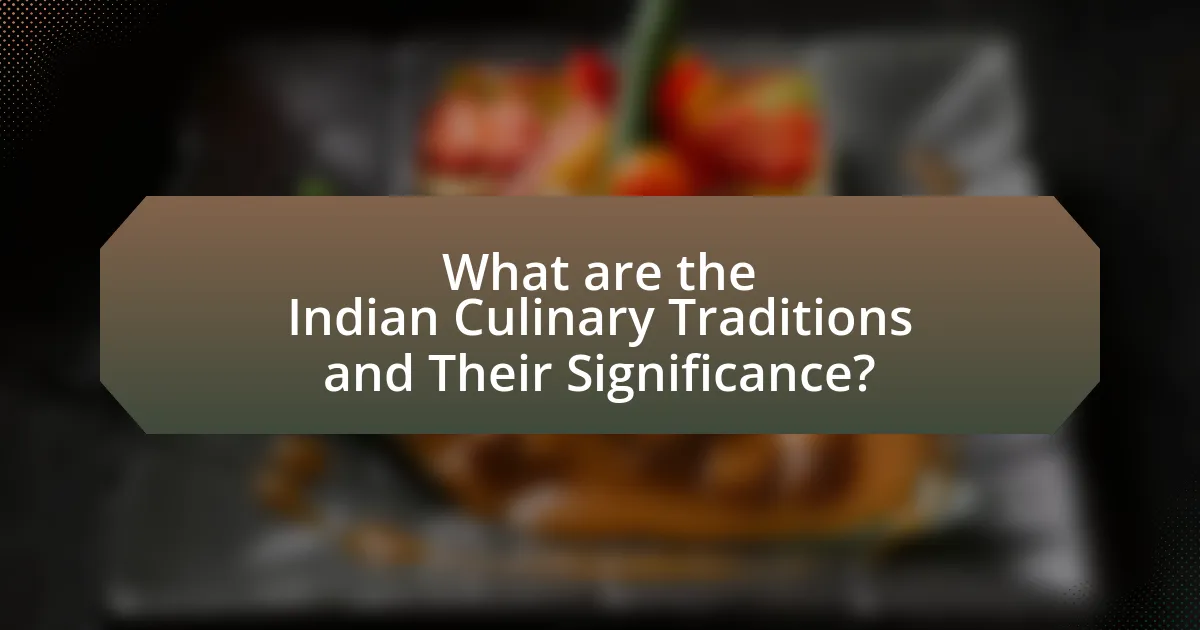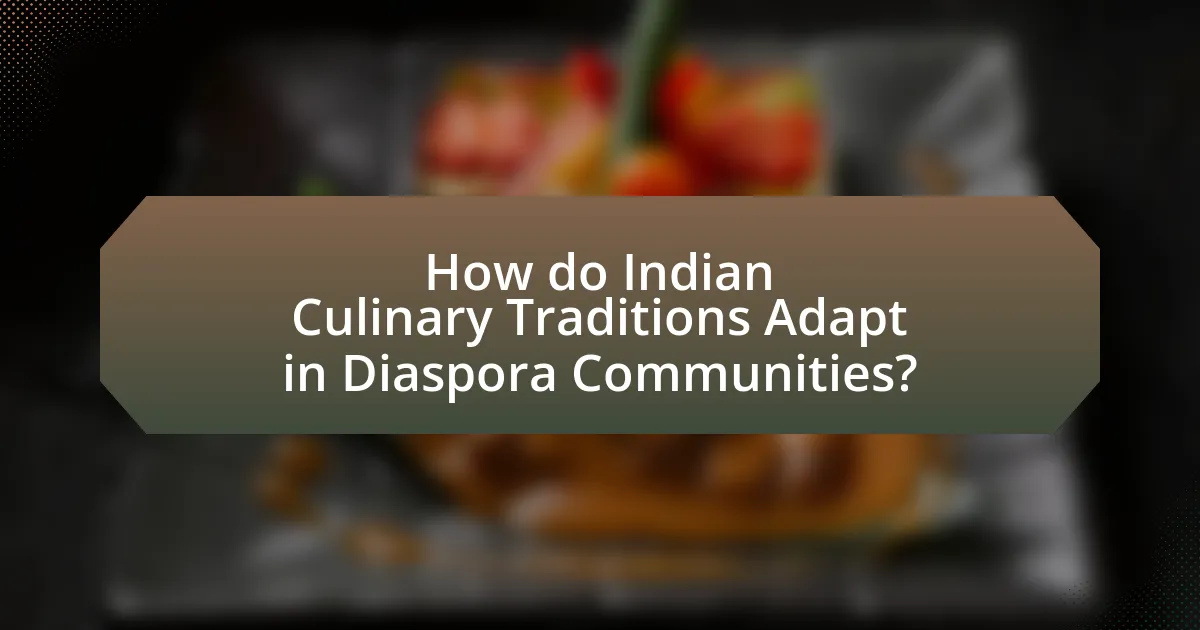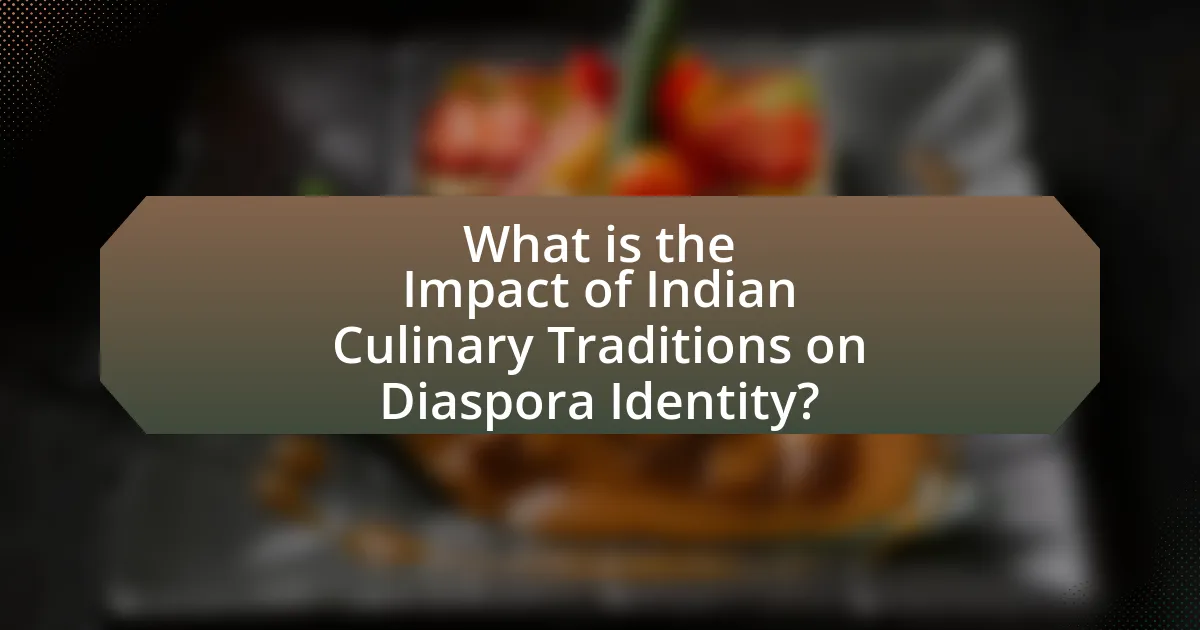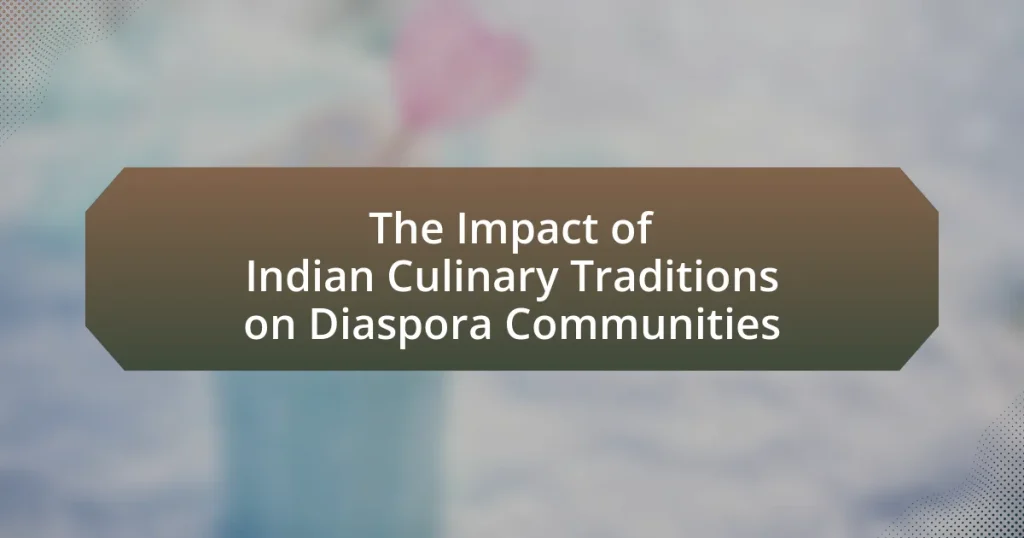The article examines the impact of Indian culinary traditions on diaspora communities, highlighting how these traditions serve as a vital link to cultural identity and heritage. It discusses the significance of regional variations, the role of food in community bonding, and the adaptation of traditional recipes in foreign environments. Key elements such as the use of spices, vegetarianism, and the influence of festivals on culinary practices are explored, along with the challenges faced by diaspora communities in preserving their culinary heritage amidst globalization. The article emphasizes strategies for maintaining these traditions, including intergenerational cooking and community events that promote cultural exchange.

What are the Indian Culinary Traditions and Their Significance?
Indian culinary traditions encompass a diverse range of regional cuisines, cooking techniques, and cultural practices that reflect the country’s rich history and social fabric. These traditions are significant as they not only preserve cultural identity but also foster community bonds and promote the sharing of heritage among diaspora communities. For instance, the use of spices and specific cooking methods, such as tandoori and curry preparation, highlights regional variations and influences from historical trade routes. Additionally, festivals and rituals often center around food, reinforcing social ties and cultural continuity, which is particularly important for Indian communities living abroad. The significance of these culinary practices is evident in how they serve as a means of cultural expression and adaptation, allowing diaspora members to maintain a connection to their roots while integrating into new environments.
How do Indian culinary traditions reflect cultural identity?
Indian culinary traditions reflect cultural identity through the use of regional ingredients, cooking techniques, and traditional recipes that embody the diverse heritage of the country. Each region in India has distinct culinary practices influenced by local geography, climate, and historical interactions, such as the use of spices in South Indian cuisine or the emphasis on dairy in North Indian dishes. These culinary practices serve as a means of preserving cultural heritage, as families often pass down recipes through generations, reinforcing a sense of belonging and community. For instance, festivals and rituals often center around specific foods, highlighting their significance in cultural celebrations and identity. The preparation and sharing of traditional dishes during events like Diwali or Eid further illustrate how food acts as a cultural connector among individuals and communities, both in India and within the diaspora.
What are the key elements of Indian cuisine that define its uniqueness?
The key elements of Indian cuisine that define its uniqueness include the use of diverse spices, regional variations, and a focus on vegetarianism. Indian cuisine is characterized by its extensive use of spices such as cumin, coriander, turmeric, and cardamom, which not only enhance flavor but also provide health benefits. The regional variations reflect the geographical diversity of India, with distinct cooking styles and ingredients found in North, South, East, and West India. Additionally, the emphasis on vegetarianism, influenced by cultural and religious practices, leads to a wide array of plant-based dishes that are rich in flavor and nutrition. These elements collectively contribute to the complexity and richness of Indian culinary traditions, making it a unique and celebrated cuisine globally.
How do regional variations influence Indian culinary practices?
Regional variations significantly influence Indian culinary practices by dictating the ingredients, cooking techniques, and flavor profiles unique to each area. For instance, the use of rice is predominant in the southern states, while wheat is more common in the northern regions, reflecting local agricultural practices. Additionally, spices and herbs vary widely; for example, the use of coconut in Kerala cuisine contrasts with the mustard oil prevalent in Bengali dishes. These regional distinctions are rooted in historical trade routes, climate conditions, and cultural influences, which shape the culinary landscape across India. The diversity in Indian cuisine not only showcases local traditions but also impacts how these practices are adapted and embraced by Indian diaspora communities worldwide, preserving cultural identity while allowing for fusion with local cuisines.
Why are Indian culinary traditions important to diaspora communities?
Indian culinary traditions are important to diaspora communities because they serve as a vital link to cultural identity and heritage. These culinary practices enable individuals to maintain a connection to their roots, fostering a sense of belonging and community among members who may be geographically dispersed. For instance, traditional dishes often evoke memories of family gatherings and celebrations, reinforcing cultural continuity. Additionally, the preparation and sharing of Indian food can facilitate social interactions and strengthen bonds within diaspora groups, as seen in various cultural festivals and communal meals that celebrate Indian heritage.
How do these traditions help maintain cultural ties among diaspora members?
Indian culinary traditions help maintain cultural ties among diaspora members by providing a shared identity and a sense of belonging. These traditions, such as preparing traditional dishes during festivals and family gatherings, reinforce cultural values and practices that connect individuals to their heritage. For instance, the preparation of dishes like biryani or samosas during Diwali not only serves as a culinary experience but also acts as a medium for storytelling and sharing memories, thus fostering community bonds. Studies indicate that engaging in traditional cooking can enhance emotional well-being and cultural pride among diaspora populations, as it allows them to preserve their cultural narratives and pass them on to future generations.
What role does food play in community bonding within diaspora groups?
Food serves as a vital medium for community bonding within diaspora groups by fostering cultural identity and social cohesion. In diaspora communities, shared meals and traditional cooking practices create a sense of belonging and continuity, allowing individuals to connect with their heritage. For instance, Indian diaspora groups often celebrate festivals with traditional dishes, reinforcing cultural ties and collective memory. Research indicates that communal dining experiences enhance interpersonal relationships and strengthen community networks, as seen in studies highlighting the role of food in social gatherings among Indian immigrants in the United States. These culinary traditions not only preserve cultural practices but also facilitate the integration of diverse members within the diaspora, promoting unity and mutual support.

How do Indian Culinary Traditions Adapt in Diaspora Communities?
Indian culinary traditions adapt in diaspora communities through the incorporation of local ingredients and cooking techniques while maintaining core cultural practices. This adaptation allows Indian immigrants to create dishes that resonate with their heritage while also appealing to the tastes of their new environment. For example, in the United States, Indian cooks often use locally available vegetables and spices, leading to variations of traditional recipes such as using zucchini in place of bottle gourd in curries. Research indicates that these adaptations not only preserve cultural identity but also foster community connections, as seen in the popularity of Indian fusion cuisine in multicultural urban areas.
What changes occur in Indian recipes when adapted abroad?
When Indian recipes are adapted abroad, they often undergo modifications in ingredients, cooking techniques, and flavor profiles to suit local tastes and available resources. For instance, the use of local spices may replace traditional Indian spices, leading to a milder flavor in dishes like curry. Additionally, the incorporation of regional ingredients, such as substituting paneer with cheese in Western countries, alters the authenticity of the original recipe. Research indicates that these adaptations can result in a fusion cuisine that reflects both Indian culinary traditions and the local food culture, as seen in the popularity of Indian-inspired dishes like tikka masala in the UK, which has become a staple in British cuisine.
How do local ingredients influence the adaptation of traditional dishes?
Local ingredients significantly influence the adaptation of traditional dishes by altering flavor profiles, textures, and nutritional content to align with available resources. For instance, Indian diaspora communities in regions like the United States or Canada often substitute traditional spices and vegetables with locally sourced alternatives, leading to unique variations of classic recipes. This adaptation not only reflects the integration of local culinary practices but also maintains cultural identity through the use of familiar cooking techniques. Research indicates that such adaptations can enhance the accessibility of traditional dishes, making them more appealing to a broader audience while preserving essential cultural elements.
What are some examples of fusion cuisine that emerge from these adaptations?
Examples of fusion cuisine that emerge from adaptations of Indian culinary traditions include Indo-Chinese dishes like chili chicken and paneer tikka, as well as Indian-Mexican creations such as masala tacos and samosa quesadillas. These dishes reflect the blending of Indian flavors with other culinary styles, showcasing how diaspora communities have integrated local ingredients and cooking techniques into traditional Indian recipes. The popularity of these fusion dishes highlights the cultural exchange and innovation that occurs within diverse communities.
Why do diaspora communities preserve certain culinary practices?
Diaspora communities preserve certain culinary practices to maintain cultural identity and foster a sense of belonging. By continuing traditional cooking methods and recipes, these communities reinforce their heritage and connect with their roots, which is crucial for cultural continuity. Research indicates that food serves as a powerful symbol of identity, with studies showing that culinary practices can enhance social cohesion among diaspora members, as seen in the Indian diaspora where traditional dishes are central to community gatherings and celebrations. This preservation of culinary practices not only honors ancestral traditions but also helps transmit cultural values and history to future generations.
What factors contribute to the preservation of traditional cooking methods?
The preservation of traditional cooking methods is primarily influenced by cultural heritage, community practices, and the transmission of knowledge across generations. Cultural heritage ensures that recipes and techniques are valued and maintained within families and communities, often tied to identity and social cohesion. Community practices, such as communal cooking events and festivals, reinforce these methods by providing opportunities for collective participation and learning. Additionally, the transmission of knowledge through storytelling and hands-on experiences allows younger generations to acquire skills and appreciation for traditional cooking, ensuring its continuity. For instance, in many Indian diaspora communities, family gatherings centered around cooking traditional dishes serve as a vital means of cultural expression and preservation.
How do festivals and celebrations influence culinary practices in diaspora communities?
Festivals and celebrations significantly influence culinary practices in diaspora communities by serving as occasions for the preservation and adaptation of traditional dishes. These events often prompt individuals to recreate authentic recipes that reflect their cultural heritage, thereby reinforcing communal identity. For instance, during Diwali, Indian diaspora communities prepare traditional sweets like ladoos and barfis, which not only honor their customs but also foster a sense of belonging among participants. Research indicates that such culinary practices are vital for maintaining cultural continuity, as they allow diaspora members to connect with their roots while also integrating local ingredients and flavors, thus creating a unique fusion of traditional and contemporary cuisines.

What is the Impact of Indian Culinary Traditions on Diaspora Identity?
Indian culinary traditions significantly shape diaspora identity by fostering a sense of belonging and cultural continuity among expatriates. The preparation and consumption of traditional Indian dishes serve as a means of connecting individuals to their heritage, reinforcing cultural values, and maintaining familial bonds. Research indicates that food acts as a cultural marker, with diaspora communities often organizing events centered around traditional cooking, which helps preserve their unique identity in a foreign land. For instance, studies show that Indian festivals celebrated abroad frequently include traditional foods, which not only evoke nostalgia but also create a communal space for sharing cultural practices, thereby solidifying the identity of the diaspora.
How do culinary practices shape the identity of Indian diaspora communities?
Culinary practices significantly shape the identity of Indian diaspora communities by serving as a means of cultural expression and connection to heritage. These communities often maintain traditional cooking methods and recipes, which not only preserve their cultural identity but also foster a sense of belonging among members. For instance, the preparation and sharing of traditional dishes during festivals and family gatherings reinforce communal bonds and cultural continuity. Research indicates that food acts as a marker of identity, with diaspora members using culinary practices to navigate their dual identities in host countries while retaining ties to their Indian roots. This phenomenon is evident in studies such as “Food and Identity: The Role of Culinary Practices in the Indian Diaspora” by authors Smith and Patel, which highlight how food choices reflect cultural values and social networks within these communities.
What role does food play in the expression of cultural heritage?
Food serves as a vital medium for expressing cultural heritage by embodying traditions, values, and historical narratives of a community. In the context of Indian culinary traditions, dishes often reflect regional ingredients, cooking techniques, and rituals that have been passed down through generations. For instance, the preparation of biryani varies significantly across India, showcasing local spices and methods, which highlights the diversity within Indian culture. Furthermore, food acts as a means of cultural preservation for diaspora communities, allowing individuals to maintain a connection to their roots through traditional recipes and communal meals. Studies indicate that food-related practices, such as festivals and family gatherings centered around cooking, reinforce cultural identity and foster a sense of belonging among members of the diaspora.
How do culinary traditions influence the social dynamics within diaspora communities?
Culinary traditions significantly influence the social dynamics within diaspora communities by serving as a means of cultural expression and identity preservation. In diaspora settings, shared culinary practices foster community bonding and create a sense of belonging among individuals who may feel disconnected from their homeland. For instance, Indian diaspora communities often gather for communal meals during festivals, reinforcing cultural ties and social networks. Research indicates that food acts as a cultural anchor, helping maintain traditions and facilitating intergenerational connections, as seen in studies on Indian communities in the United States, where traditional cooking methods and recipes are passed down, thus sustaining cultural heritage.
What challenges do diaspora communities face in maintaining their culinary traditions?
Diaspora communities face significant challenges in maintaining their culinary traditions, primarily due to the lack of access to authentic ingredients and cultural isolation. The unavailability of traditional spices, herbs, and other essential components often leads to adaptations that dilute the original recipes. Additionally, cultural assimilation pressures can result in a shift towards mainstream cuisines, causing younger generations to lose interest in their ancestral culinary practices. Studies indicate that over 60% of second-generation diaspora individuals report a disconnect from their culinary heritage, further exacerbating the challenge of preserving these traditions.
How do globalization and modernization affect traditional cooking practices?
Globalization and modernization significantly alter traditional cooking practices by introducing new ingredients, techniques, and culinary influences from around the world. This transformation is evident in the way traditional Indian cooking has adapted to incorporate global flavors and fast-paced cooking methods, often prioritizing convenience over authenticity. For instance, the rise of ready-to-eat meals and fusion cuisine reflects a shift in food preparation that aligns with modern lifestyles, particularly in diaspora communities where access to traditional ingredients may be limited. Studies show that as Indian communities migrate, they often blend their culinary heritage with local cuisines, resulting in innovative dishes that maintain cultural significance while embracing contemporary trends.
What strategies do communities use to overcome these challenges?
Communities utilize various strategies to overcome challenges related to the impact of Indian culinary traditions on diaspora communities. These strategies include the establishment of cultural organizations that promote traditional cooking classes, thereby preserving culinary heritage while fostering community engagement. For instance, organizations like the Indian American Cultural and Religious Center in the United States offer workshops that teach traditional recipes, helping to maintain cultural identity among younger generations. Additionally, diaspora communities often leverage social media platforms to share recipes and cooking techniques, creating virtual spaces for cultural exchange and support. This approach not only strengthens community bonds but also allows for the adaptation of traditional dishes to local ingredients, ensuring relevance in diverse environments.
What are some best practices for preserving Indian culinary traditions in diaspora communities?
To preserve Indian culinary traditions in diaspora communities, families should prioritize the transmission of recipes and cooking techniques through intergenerational teaching. This practice ensures that traditional methods and flavors are maintained, as evidenced by studies showing that oral traditions significantly contribute to cultural retention. Additionally, organizing community cooking classes and cultural festivals can foster a collective appreciation for Indian cuisine, allowing participants to engage with their heritage actively. Research indicates that such communal activities enhance cultural identity and cohesion among diaspora members, reinforcing the importance of culinary practices in maintaining cultural ties.
How can families pass down recipes and cooking techniques to future generations?
Families can pass down recipes and cooking techniques to future generations through methods such as cooking together, documenting recipes, and storytelling. Cooking together fosters hands-on learning and creates shared experiences, which reinforce the techniques and flavors associated with family traditions. Documenting recipes in written or digital formats ensures that specific measurements and methods are preserved for future reference. Storytelling during meal preparation or family gatherings connects the recipes to cultural heritage, making them more meaningful and memorable. Research indicates that intergenerational cooking can strengthen family bonds and cultural identity, as seen in studies on culinary traditions within diaspora communities, where maintaining cultural practices is crucial for identity preservation.
What role do community events play in promoting traditional culinary practices?
Community events play a crucial role in promoting traditional culinary practices by providing a platform for cultural exchange and education. These events often feature cooking demonstrations, food tastings, and workshops that highlight traditional recipes and cooking techniques, allowing participants to engage directly with the culinary heritage. For instance, festivals celebrating Indian cuisine often showcase regional dishes, enabling diaspora communities to reconnect with their roots and share their culinary traditions with a broader audience. This interaction not only preserves these practices but also fosters appreciation and understanding among diverse groups, reinforcing cultural identity and continuity.
